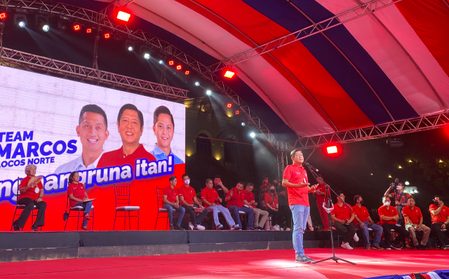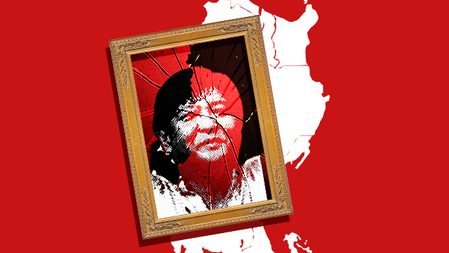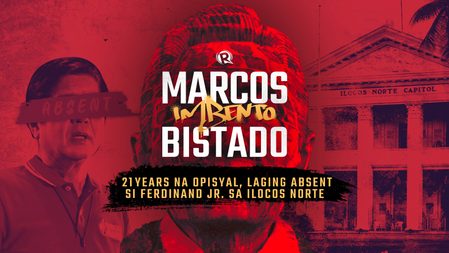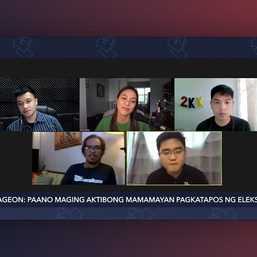SUMMARY
This is AI generated summarization, which may have errors. For context, always refer to the full article.
![[OPINION] The Marcos dynasty and the battle for Ilocos Norte](https://www.rappler.com/tachyon/2022/03/tl-battle-for-ilocos-norte.png)
Even as the Marcoses are getting closer to pulling off the biggest political comeback the Philippines will have ever seen, they are simultaneously plotting their complete domination of the politics of Ilocos Norte, the very base of this astonishing would-be restoration of their political fortunes. Ferdinand Marcos Jr launched his political career as governor in 1992, shortly after returning from exile in November 1991.
The province’s first congressional district is the new political battleground for the Marcoses to completely own Ilocos Norte provincial politics.
In the past, they had their eyes only on the gubernatorial and second district congressional positions, with the latter having a deeply historical and, probably even “spiritual,” meaning for them. Hence, they registered as residents and voters of the second district, which includes Batac where the dictator grew up.
Since the return of local elections in 1988, the occupants of the Ilocos Norte capitol have come from only two families: the Marcoses and the Fariñases. Rodolfo Fariñas was governor from 1988 to 1998. Since then, the province has been ruled by a Marcos, including the defeat in 2007 of the veteran Rodolfo Fariñas to the newcomer Michael Marcos-Keon, son of Elizabeth Marcos-Keon, governor from 1971 to 1983 and who was Ferdinand Marcos’ sister.
Similarly, the province’s second congressional district has been represented since 1998 by a Marcos or a close Marcos relative. The seat passed from Imee Marcos (1998-2007) to her brother Ferdinand Jr. (2007-2010) to their mother, Imelda (2010-2019) to the incumbent Angelo Marcos Barba (2019-2022), Imee’s first-degree cousin. Since 1946, a Marcos has represented the second district for 37 years, including the ten years of Ferdinand Marcos (1949-1959).
Whereas the Marcoses have dominated the second district, no Marcos has represented Ilocos Norte’s first district. Roque Ablan Jr. dominated it, representing it from 1968 to 1998 and 2001-2010. Rodolfo Fariñas represented it from 1998 to 2001 and 2010-2019. His daughter, Ria, succeeded him in 2019.
It is widely understood in Ilocos Norte that there had been a mutually beneficial political existence between the Marcoses and Fariñases built around the clear delineation of the domains of each family. The first district for the Fariñases and the second district for the Marcoses. They both have held the governorship, but never running against each other.
But this division began to break down when the alliance between unraveled. In 2007, the Marcoses supported the gubernatorial candidacy of their cousin Michael Marcos Keon, who defeated Rodolfo Fariñas. To restore the alliance, Marcos-Keon would be prevailed upon not to run for re-election. When he refused to be a mere chess piece of the Marcoses and Fariñases, Imee Marcos ran in 2010 as governor and defeated him, her first-degree cousin.
The relationship between the two families reached a nadir in 2017 with the controversy around the misuse of the province’s tobacco funds to purchase (overpriced) buses and multi-cabs in 2012 without public bidding. Fariñas, then House majority floor leader, who led the House investigation, was declared by the provincial board a persona non grata. A truce brokered between the families saw Rodolfo Fariñas withdraw his candidacy for the governorship in 2019 in favor of Imee Marcos’ son, Matthew Marcos Manotoc, who ran unopposed.
But the Marcoses now want the first district for themselves. In September of 2015, all three sons of Marcos Jr., then a senator, registered as voters of Laoag City. Prior to the move of the young Marcos scions, Imee Marcos registered as a Laoag City resident in May 2015. This change in domicile was a prelude to bringing the first district into their domain.
As residents of Laoag City, Imee and Marcos Jr.’s sons could run as first district representative or mayor of the capital city, which, until 2019, was under the Fariñases. For the Marcoses, two new additional positions to go with the governorship and second district congressional post would consolidate their grip on the levers of power in Ilocos Norte.
With more third-generation Marcoses waiting in the wings, these two new posts would reduce their having to hang around waiting for their turn to hold power. If Marcos Jr. and Imee wanted to return to provincial or congressional politics, no one would have to give up a post. They only have to rotate.
The agreement brokered between the Marcoses and Fariñases in 2019 that led to Rodolfo Fariñas withdrawing from the gubernatorial race suggests the Marcoses would not contest the first district congressional position currently held by Fariñas’ daughter, Ria. Thus, the candidacy of Sandro, Marcos Jr.’s oldest son, forced Rodolfo Fariñas out of retirement to run for governor against Matthew Marcos Manotoc. Rodolfo Fariñas accused the Marcoses of destroying the unity of the Solid North.
The outcome of the 2022 gubernatorial and congressional elections will spell the fortunes of both families, but especially the Fariñases. If the Fariñases lose, it will be difficult for them to recover. They need to win Laoag City if they are to avoid a political wipeout. If the Fariñases win, the Marcoses will still have a political base in the second district.
If the young Marcoses are victorious, the people of Ilocos Norte would be the ultimate losers. Not because the Fariñases offer a real alternative but because political dynasties undermine democracy and economic development.
Teresa Encarnacion Tadem and Eduardo Tadem have noted that political dynasties perpetuate poverty and underdevelopment, entrench political and socio-economic inequality, and encourage massive corruption. Rollin Tusalem and Jeffrey Pe-Aguirre also conclude that provinces dominated by political dynasties are less likely to enjoy good governance measured according to infrastructure development, spending on health, rate of criminality, full employment, and overall quality of government. Also, political dynasties severely limit people’s choice and the winner is unlikely to be the most fitted for public office.
In Ronald Mendoza and colleagues’ study of political dynasties in the 15th Philippine Congress, Ilocos Norte ranked 5th according to dynastic share (after Maguindanao, Apayao, Sulu, and Tawi-Tawi). The potential complete domination by the Marcoses of Ilocos Norte in the 2022 elections removes political competition which, together with the prevalence of political dynasties, impacts negatively on socio-economic outcomes.
Since 1997, Ilocos Norte has been in the top quartile of provinces with the highest HDI (Human Development Index). In 2015, the province ranked 12th. This is not because of its level of economic development. The province is in fact heavily dependent on remittances. 21.7% of its total income in 2009 came from overseas remittances. The figures for the country and Ilocos Region were 11.6% and 17.9% respectively.
Almost 43% of its households depend on foreign remittances, with 31.4% of families depending on remittances for at least 25% of their household income. Another 11.4% of families depend on remittances for at least 50% of their household income. It is estimated that Ilocos Norte receives between P15-18 billion in remittances annually.
Poverty remains a big problem. A study profiling poverty in the province found that regardless of a town’s income classification (whether first class or fifth class), the poverty conditions are consistent. Access to health facilities, potable water, and electricity becomes much more difficult for remote barangays. People suffer from unemployment or precarious sources of income, landlessness, and lack of education.
A recent study conducted by DepEd Region I’s Policy, Planning and Research Division (PRRD) revealed that 207 barangays in Ilocos Norte do not have an elementary school, increasing the chances of schoolchildren dropping out. With 559 barangays, that means 37% of barangays in Ilocos Norte are without an elementary school.
The lack of political competition will certainly have detrimental consequences on Ilocos Norte. All the Marcoses need to do when they are in power, and to stay in power, is do just enough. It is doubtful that their motivations for running for elective positions arise from a genuine sense of public service.
The Marcoses’ desire to consolidate power goes with a dislike for those who can offer alternative leadership. What Imee Marcos did as governor to the Valdezes of San Nicolas, Ilocos Norte exemplifies this desire to subdue anyone who posed a threat. Alfredo and Hilario Valdez engineered the massive socio-economic development of the town. Their governance and socioeconomic development became a model for Laoag City.
Wataru Kusaka has detailed how Imee put obstacles to the economic-development plans of the Valdezes. These included rejection of their application for tax incentives, rejection of their application for quarry permits for two years while Imee granted those of others, and the town’s exclusion from allocation of farm-to-market road funds provided by two senators. Imee also demanded investors not to exclusively invest in San Nicolas.
Alfredo and Hilario Valdez, themselves relatives of the Marcoses, were allegedly a thorn on the side of Imee Marcos who wanted to get rid of them. In the 2010s, stories spread she planned on fielding Matthew Marcos Manotoc for the mayoralty post and hence had him register as a resident of San Nicolas. There was, however, no chance he could unseat a Valdez in San Nicolas. He went instead for the provincial board. But Hilario Valdez lost in 2019 the second district congressional election to Angelo Marcos Barba, a cousin of the Marcoses whom they of course backed. Threat neutralized.
Since being allowed to come back in 1991, the Marcoses have had to wait for only 31 years to have a clear path back to Malacanang.
Will the 34-year-old Matthew Marcos Manotoc vanquish the 71-year-old veteran Rodolfo Fariñas? Will Ferdinand “Sandro” Marcos, 28, become Ilocos Norte’s new congressman? The answer is in the hands of the Ilokanos.
Will Ferdinand Marcos Jr. become the 17th president of the Philippines? That is in Filipinos’ hands, which might yet deal him a knockout blow.
May the force be with those hands. – Rappler.com
Roderick Galam is a Senior Lecturer in the School of Social Sciences at Oxford Brookes University. After graduating from the University of the Philippines Diliman, he taught at the Mariano Marcos State University in Batac, Ilocos Norte. A sociologist and literary scholar, he has written two books on Ilokano society, culture, and literature. He was previously affiliated with the Freie Universitaet Berlin.
Add a comment
How does this make you feel?



![[OPINION] A genuine Ilokano’s reflections on Marcos loyalism](https://www.rappler.com/tachyon/2022/03/Reflections-on-Ilokanos-Marcos-loyalism.jpg?fit=449%2C449)
![[WATCH] In The Public Square with John Nery: Preloaded elections?](https://www.rappler.com/tachyon/2023/04/In-the-Public-Square-LS-SQ.jpg?resize=257%2C257&crop=414px%2C0px%2C1080px%2C1080px)
![[Newspoint] 19 million reasons](https://www.rappler.com/tachyon/2022/12/Newspoint-19-million-reasons-December-31-2022.jpg?resize=257%2C257&crop=181px%2C0px%2C900px%2C900px)

![[OPINION] The long revolution: Voices from the ground](https://www.rappler.com/tachyon/2022/06/Long-revolution-June-30-2022.jpg?resize=257%2C257&crop=239px%2C0px%2C720px%2C720px)
![[OPINION] I was called a ‘terrorist supporter’ while observing the Philippine elections](https://www.rappler.com/tachyon/2022/06/RT-poster-blurred.jpeg?resize=257%2C257&crop_strategy=attention)








![[OPINION] If it’s Tuesday it must be Belgium – travels make over the Marcos image](https://www.rappler.com/tachyon/2024/04/tl-travel-makeovers-marcos-image.jpg?resize=257%2C257&crop_strategy=attention)

There are no comments yet. Add your comment to start the conversation.